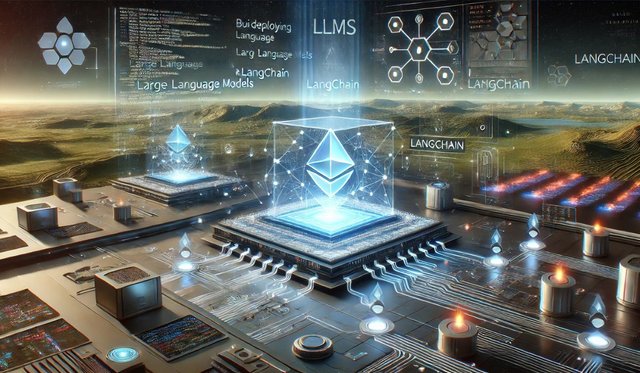How Do You Build and Deploy AGENTIC AI Workflow Using LLM and LangChain?
As the AI landscape evolves, developers are looking beyond simple chatbots and large language model (LLM) outputs. Today, the focus is shifting toward creating autonomous agents—AI systems that can reason, take initiative, and interact with tools, environments, and APIs. One powerful approach to achieving this is to Build and Deploy AGENTIC AI Workflow Using LLM and LangChain. LangChain, an open-source framework, enables developers to structure LLM-powered applications as agents, making them capable of planning, reasoning, and tool use. In this blog, we’ll explore what agentic AI is, how LangChain facilitates it, and walk through a detailed guide to building and deploying your own agentic AI workflow.
What is Agentic AI?
Agentic AI refers to AI systems that act with autonomy and intention, performing complex tasks with minimal human intervention. Unlike traditional prompt-and-response LLM apps, agentic AI applications use reasoning loops and memory, and they interact with multiple tools to complete tasks.
For instance, rather than simply answering a user’s question, an agentic AI could:
Search the web
Access a database
Summarize documents
Execute code
Loop through multi-step reasoning processes
This level of sophistication enables real-world applications such as:
Autonomous research assistants
AI customer service bots
Workflow automation agents
Data analysis companions
LangChain provides the essential framework for managing these complex workflows using components like Chains, Agents, Tools, Memory, and Callbacks.
Understanding the Core Components
Before we dive into building the workflow, let’s explore the foundational blocks LangChain uses to build agentic AI systems.
1. LLMs (Large Language Models)
LLMs like OpenAI’s GPT, Anthropic’s Claude, or open-source models like LLaMA and Mistral form the reasoning engine for agentic systems. LangChain provides a unified API to connect with these LLMs.
2. Chains
Chains are sequences of calls to an LLM (or other components). Simple chains may take user input and call an LLM. More advanced chains can process output from one step and pass it to another.
3. Agents
Agents are dynamic workflows. Instead of following a fixed sequence, agents decide at runtime which tools to use and what actions to take based on the task at hand.
4. Tools
These are external capabilities the agent can call, such as a search API, calculator, Python interpreter, or custom functions like database access.
5. Memory
Memory allows the agent to store information across turns or tasks. This can be essential for conversation or cumulative problem-solving.
Step-by-Step: Build and Deploy AGENTIC AI Workflow Using LLM and LangChain
Here’s how to build your own agentic AI from scratch using Python and LangChain.
Step 1: Install Required Libraries
bash
CopyEdit
pip install langchain openai python-dotenv
Also, ensure your .env file contains your API key:
bash
CopyEdit
OPENAI_API_KEY=your_openai_key
Step 2: Initialize Your LLM
python
CopyEdit
`from langchain.chat_models import ChatOpenAI from dotenv import load_dotenv
load_dotenv()
llm = ChatOpenAI(temperature=0, model_name="gpt-4")`
Step 3: Define Tools for the Agent
LangChain includes several built-in tools. You can also define your own.
python
CopyEdit
`from langchain.agents import Tool from langchain.tools import DuckDuckGoSearchRun
search = DuckDuckGoSearchRun()
tools = [
Tool(
name="Search",
func=search.run,
description="Use this to search the web for current information." )
]`
Step 4: Create the Agent
python
CopyEdit
`from langchain.agents import initialize_agent from langchain.agents.agent_types import AgentType
agent = initialize_agent(
tools=tools,
llm=llm,
agent=AgentType.ZERO_SHOT_REACT_DESCRIPTION,
verbose=True )`
Step 5: Execute the Agent
python
CopyEdit
response = agent.run("What is the latest AI research on climate change?") print(response)
Now, your AI agent uses both its reasoning ability and the web search tool to answer complex queries dynamically.
Step 6: Add Memory for Stateful Agents
You can use LangChain's memory module to allow multi-turn conversations.
python
CopyEdit
`from langchain.memory import ConversationBufferMemory
memory = ConversationBufferMemory(memory_key="chat_history")
agent_with_memory = initialize_agent(
tools=tools,
llm=llm,
agent=AgentType.CONVERSATIONAL_REACT_DESCRIPTION,
memory=memory,
verbose=True )
agent_with_memory.run("Who is the president of the USA?")
agent_with_memory.run("What is his latest policy update?")`
The agent remembers context, making interactions more coherent and human-like.
Deployment Considerations
Once your agentic AI is working locally, it’s time to consider deployment.
1. Dockerize Your Application
Create a Dockerfile to containerize your app for deployment.
dockerfile
CopyEdit
FROM python:3.10 WORKDIR /app COPY . . RUN pip install -r requirements.txt CMD ["python", "main.py"]
2. Cloud Deployment
You can deploy to any cloud provider (AWS, GCP, Azure) or platform-as-a-service tools like:
Render
Vercel (for frontend + serverless functions)
Fly.io
FastAPI + Docker on EC2
3. API Integration
Wrap your LangChain agent in an API using Flask or FastAPI to integrate it with your frontend or third-party apps.
Advanced Tips for Agentic AI Workflows
✅ Tool Chaining
You can chain tools together for advanced tasks. For example, search → summarize → email.
✅ Memory Types
Try out different memory options like ConversationSummaryMemory or VectorStoreRetrieverMemory.
✅ Custom Tools
Define tools that interact with APIs, databases, or internal business logic for use-specific needs.
✅ Observability
Use LangChain’s callbacks and logging utilities to trace agent decisions and optimize behavior.
Real-World Use Cases
Customer Support Agents – Automate tier-1 queries with LLM-powered agents that access knowledge bases.
Personal Assistants – From booking travel to summarizing emails, agentic AI can handle complex workflows.
Research Analysts – Automate literature reviews or summarize findings from the web and PDFs.
Marketing Automation – Create agents that generate and distribute content across platforms.
Conclusion: The Future of AI Agent Development
As enterprises increasingly adopt LLM-powered applications, the need for autonomous and intelligent agents is surging. By learning how to Build and Deploy AGENTIC AI Workflow Using LLM and LangChain, you position yourself at the forefront of the AI revolution. LangChain’s agent-based architecture, combined with powerful LLMs and flexible tool integration, offers a robust foundation for deploying next-gen AI systems.
Whether you’re building internal automation, customer-facing assistants, or entirely new AI products, the key lies in AI Agent Development—an area poised to transform industries across the board.
